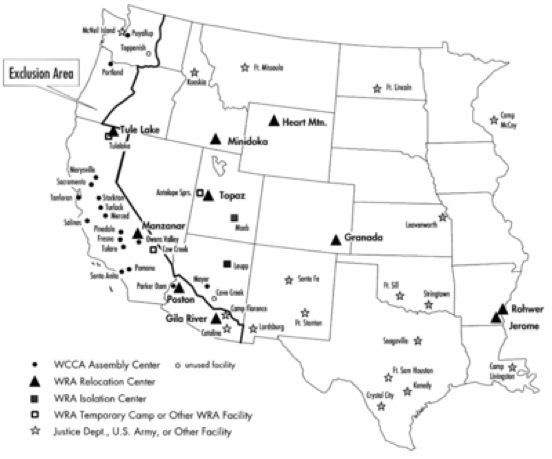Tule Lake Japanese Internment Camp

Tule Lake Internment Camp is located in Northern California about 30 miles from Klamath Falls, Oregon. During World War II over 18,000 persons of Japanese Ancestry were placed in this desolate area - hot and dusty in summer, and cold and muddy in winter.
Tule Lake, along with nine other camps were established by President Roosevelt. In 1942, soon after the bombing of Pearl Harbor, Executive Order 9066 was issued. Wartime hysteria and the already present anti-Asian racism on the West Coast allowed the U.S. Government to use Executive Order 9066 to remove residents of Japanese descent from their homes. In total 110,000 -120,000 Japanese Americans were forced to relinquish their personal possessions - homes, farms, businesses - and especially their freedom. Japanese Americans were given very little time to pack what possessions they could carry, were processed through assembly centers and then taken, mostly by train, to ten concentration camps.
In 1982 a Presidential commission reported that there was no military necessity for the relocation camps. The internment, the commission found, was in response to "race prejudice, war hysteria, and a failure of political leadership". Sabotage and espionage never happened.
On August 10, 1988, President Ronald Reagan signed legislation apologizing for the the government’s actions.

Internees were segregated into “loyals” and “disloyals” with the War Relocation Authority’s (WRA) questionnaire. This questionnaire was mandatory for all internees 17 years or older. This process of “registration” was never clear to the internees. Questions 27 and 28 are the most problematic.
#27: Are you willing to serve in the armed forces of the United States wherever ordered?
#28: Will you swear unqualified allegiance to the United States of America and faithfully defend the United States from any or all attack by foreign or domestic forces, and forswear any form of allegiance or obedience to the Japanese emperor, or any other foreign government, power, or organization?
Issei (First Generation Immigrants) were never allowed by law to become citizens and many struggled with English. Answering “Yes” to #28 would leave them without a country.
Nisei (Second Generation) were Americans by birth. They were asked to forswear “allegiance or obedience” to an emperor who was foreign to them - many knew of the emperor in name only. Some thought that this was a trick question. Some also thought that answering yes to #27 was basically volunteering for military service.
In all 75,000 internees filled out the questionnaire. 12,173 so-called “disloyals” (No-No’s - no to both questions) were identified and sent to Tule Lake.
View Photos of Mr. Gulka’s 2006 Tule Lake Pilgrimage
Link to Mr. Gulka’s Tule Lake Pilgrimage Photos
For an exhaustive history of Tule Lake download this PDF -tulelakesegregation.pdf
